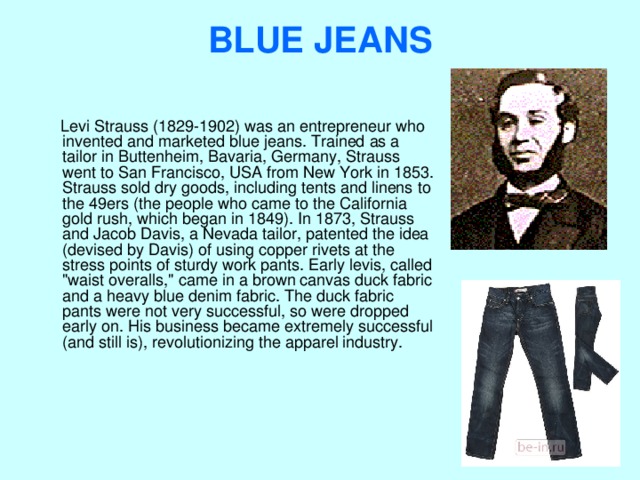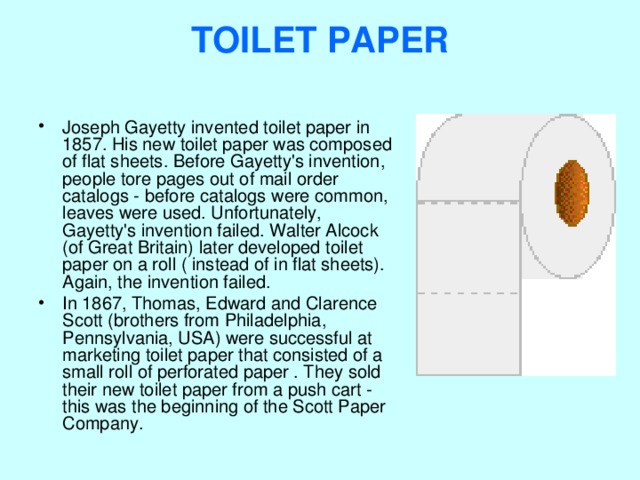
Gymnasium 10
10 great i nventions that changed our World
Tchesnokova A. V., teacher of English
2016

Inventions that changed the world

Top 10 ‘ I nventions' that changed the world
Scientists from the British Science Association have drawn up a list of the top 10 things that have changed the world.

1. GPS Technology
- Originally developed as a navigation system by the United States military, the Global Positioning System uses a network of satellites around the Earth to pinpoint the exact position of a receiver anywhere on the planet.
- Since its development in 1978, it is now used in cars, aircraft and boats. Geologists use it to track the movements of continental plate tectonics and glaciers while conservation scientists have tagged turtles with GPS receivers to follow their epic migrations.

2. The Sony Walkman
- In 1979 Sony spawned the era of wearable technology with its iconic personal stereo. It enabled music fans to listen to their music while on the move without inflicting their choices on those around them. It provided the soundtrack to millions of morning commutes.
- The Walkman quickly changed listening habits and became hugely popular as jogging culture took the 1980s by storm – here was something that allowed you to listen to your music while you worked out.
- This wearable technology has now evolved, thanks to Apple, into the iPod and has changed music for ever.

3. The Bar code
- These boring sets of black and white lines can now be found on almost every single item bought from a shop. At first glance, it seems hard to see how they possibly made any impact on the world, but they have fundamentally changed the way we shop.
- Norman Woodland first developed an early form of the bar code in 1949 by combining ideas from movie soundtracks and Morse code to help him speed up store checkouts. They now stores to instantly access product details, prices and stock levels with a sweep of a laser.

4. TV Dinners
- Food on the go has been around since the time of Ancient Greece, but convenience food really took off in the 1970s and transformed the way families ate meals, the high-street, the countryside and national health.
- Traditional family dinners around the table disappeared and pre-packaged "ready meals" eaten on the sofa became the norm. Due to hectic lifestyles, the products, which were often frozen, were designed to make life easier for time-pressed consumers.
- The popularity of processed food, however, is also blamed for driving the obesity crisis. With high fat, salt and sugar content to make the meals last longer on the shelves, the diet of the Western world has deteriorated.

5. PlayStation
- Although games consoles had been around for some time, Sony’s Playstation took gaming out of spotty teenager's bedrooms and into adult living rooms when it was released in 1994.
- Here was a computer with more power than the average family PC. As of July 2008 more than 102 million PlayStation units have been sold, while the next generations, PlayStation 2 and PlayStation 3, have also been turned into best sellers.
- The gaming industry is now worth almost as much as the film industry, taking in more than £15 billion in 2008.

6. Social Networking
- Around the world, every day, more than three billion minutes are spent by computer users on Facebook. Along with other social networking sites such as MySpace and Twitter, it has completely changed the way we interact and who we interact with.
- Millions of people now communicate tiny details of their professional and personal lives by poking, twittering and posting. Online social networking has allowed people to rekindle friendships with friends they lost touch with years ago.
- Others chat online with complete strangers on the other side of the world.
- In 1967 American psychologist Stanley Milgram conducted the small world experiment to prove the strength of old fashioned social networks. In the digital age, his six degrees of separation have almost become redundant.

7. Text messages
- Text messaging has created a new vocabulary and new grammar that is almost incomprehensible to those who do not use it. LOL and FYI have now passed into everyday English.
- It has also changed the way people use their thumbs – the old QWERTY keyboard layout suddenly became redundant. Among 13-17 year olds, text messaging now outweighs old fashioned phone calls by seven to one.

8. Electronic Money
- In the UK there were 7.4 billion purchases made during 2008 with plastic cards. Combined with internet banking, cards have made the cheque almost redundant.
- Credit cards gave us greater convenience for spending, greater security and the ability to spend money anywhere in the world. They also brought us internet fraud and record levels of debt that have contributed to the global credit crunch.

9. Microwaves
- Not the ovens, but the electromagnetic waves. Microwaves – electromagnetic radiation with wavelengths ranging between 1 millimetre and one metre – are used by mobile phones, wireless broadband internet and satellite television.
- Radar, which helped Britain win the Battle of Britain, also uses microwave radiation. They also gave us a new way of cooking food while the US military has developed a "less-than-lethal" weapon that can blast victims with a heatwave.

10. Trainers
- Nightclub bouncers might not like them, but trainers changed fashion and the feet of generations. The Goodyear Metallic Rubber Shoe Company was the first to use a new manufacturing process that melded rubber to cloth in 1892, but it was not until the 1970s they took off.
- With the help of celebrity endorsements by sporting superstars such as basketball legend Michael Jordan, trainers turned from being purely practical clothing for sport into a fashion item.
- The Army now reports that young people are increasingly growing up without ever wearing leather shoes and their feet are now too soft to wear traditional miliary boots.
![Other inventions: AEROSOL SPRAY CAN The forerunner of the aerosol can was invented by Erik Rotheim of Norway. On November 23, 1927, Rotheim patented a can with a valve and propellant systems - it could hold and dispense liquids. The first aerosol can (a can than contains a propellant [a liquefied gas like flurocarbon] and has a spray nozzle) was invented in 1944 by Lyle David Goodloe and W.N. Sullivan. They were working for the U.S. Department of Agriculture and were trying to find a way to spray and kill malaria carrying mosquitos during World War II for the soldiers overseas. The](https://fhd.multiurok.ru/c/d/1/cd1b2707b56741d7b0af222547ef2d4ffbf865aa/img13.jpg)
Other inventions: AEROSOL SPRAY CAN
- The forerunner of the aerosol can was invented by Erik Rotheim of Norway. On November 23, 1927, Rotheim patented a can with a valve and propellant systems - it could hold and dispense liquids.
- The first aerosol can (a can than contains a propellant [a liquefied gas like flurocarbon] and has a spray nozzle) was invented in 1944 by Lyle David Goodloe and W.N. Sullivan. They were working for the U.S. Department of Agriculture and were trying to find a way to spray and kill malaria carrying mosquitos during World War II for the soldiers overseas. The "clog-free" spray valve was invented by Robert H. Abplanal in 1953.
- The first spray paint was invented by Edward H. Seymour in 1949. Seymour's wife Bonnie had given him the idea of an aerosol applicator for paint. The first spray paint he developed was aluminum colored. Seymour formed the company, Seymour of Sycamore, Inc. of Chicago, USA, which is still in operation.

AQUALUNG
The aqualung is a breathing apparatus that supplied oxygen to divers and allowed them to stay underwater for several hours. It was invented in 1943 by Jacques-Yves Cousteau (1910 -1997) and the French industrial gas control systems engineer Emile Gagnan. Among the innovations in their device was a mechanism that provided inhalation and exhaust valves at the same level. That summer, the new device was tested in the Mediterranean Sea down to 210 ft (68 m) by Cousteau, Philippe Tailliez, and Frédérik Dumas. This safe, easy-to-use, and reliable device was the first modern scuba system.

ASSEMBLY LINE
Primitive assembly line production was first used in 1901 by Ransome Eli Olds (1864-1950), an early car-maker (he manufactured the Oldsmobile, the first commercially successful American car). Henry Ford (1863-1947) used the first conveyor belt-based assembly-line in his car factory in 1913-14 in Ford's Highland Park, Michigan plant. This type of production greatly reduced the amount of time taken to put each car together (93 minutes for a Model T) from its parts, reducing production costs. Assembly lines are now used in many manufacturing processes.

BAND-AID®
Bandages for wounds had been around since ancient times, but an easy-to-use dressing with an adhesive was invented by Earle Dickson (a cotton buyer at the Johnson & Johnson company). Dickson perfected the BAND-AID® in 1920, making a small, sterile adhesive bandage for home use. Dickson invented the BAND-AID® for his wife, who had many kitchen accidents and needed an easy-to-use wound dressing. Dickson was rewarded by the Johnson & Johnson company by being made a vice-president of the company.

B asketball
The game of basketball was invented by James Naismith (1861-1939). Naismith was a Canadian physical education instructor who invented the game in 1891 so that his students could participate in sports during the winter. In his original game, which he developed while at the Springfield, Massachusetts YMCA (Young Men's Christian Association), Naismith used a soccer ball which was thrown into peach baskets (with the basket bottoms intact). The first public basketball game was in Springfield, MA, USA, on March 11, 1892. Basketball was first played at the Olympics in Berlin Germany in 1936 (America won the gold medal, and Naismith was there).

BLUE JEANS
Levi Strauss (1829-1902) was an entrepreneur who invented and marketed blue jeans. Trained as a tailor in Buttenheim, Bavaria, Germany, Strauss went to San Francisco, USA from New York in 1853. Strauss sold dry goods, including tents and linens to the 49ers (the people who came to the California gold rush, which began in 1849). In 1873, Strauss and Jacob Davis, a Nevada tailor, patented the idea (devised by Davis) of using copper rivets at the stress points of sturdy work pants. Early levis, called "waist overalls," came in a brown canvas duck fabric and a heavy blue denim fabric. The duck fabric pants were not very successful, so were dropped early on. His business became extremely successful (and still is), revolutionizing the apparel industry.

BUBBLE GUM
Bubblegum was invented by Frank Henry Fleer in 1906, but was not successful; the formulation of Fleer's "Blibber-Blubber," was too sticky. In 1928, Walter E. Diemer invented a superior formulation for bubble gum, which he called " Double Bubble."

FOUNTAIN PEN
Lewis E. Waterman was an American inventor and insurance salesman who developed a relatively leak-proof fountain pen; he patented his new invention in 1884 and revolutionized writing. Before his fountain pen, pen tips had to be tipped into ink after every few words. Waterman put an ink reservoir in the pen above the pen's metal nib (point). This reservoir would hold enough ink for a few pages of writing. There were many problems in developing the fountain pen, especially the difficulty of controlling the flow of the ink. Putting a sealed reservoir above the nib wouldn't let the ink flow, but if it wasn't sealed, all the ink would flow at once. Waterman used capillary action to replace the ink in the rubber sac with air so that the ink flowed smoothly but did not flow all at once. Also, the metals in the ink dissolved the steel pen nib, so Waterman used an iridium-plated gold nib. Waterman was also the first person to place a clip on the cap of the pen.

PAPER
- Paper is writing material made from wood pulp or other fibrous material.
- Almost 5,000 years ago, in ancient Egypt, the papyrus plant was processed and used as paper. Papyrus paper was made from thin sheets of papyrus pith that were soaked in water, pressed together with the grains at right angles, and then dried - the sticky sap of the plant made the thin sheets stick together, forming a sturdy writing surface. Papyrus ( Cyperus papyrus is its genus and species) is a grass-like aquatic plant native to the Nile valley of Egypt. Our word paper comes from "papyrus."
- Paper is made by grinding plant material into a pulp, forming it into thin sheets, and drying it in a form. This process was invented in AD 105 by Ts'ai Lun, a Chinese official and member of the Chinese Imperial Court, about 2000 years ago; he originally used the waste from silk production. Early Chinese paper was made from the bark of the mulberry tree and other plant fibers.

POLAROID CAMERA
The Polaroid camera is a camera that develops the photograph while you wait (one-step photography ). It was invented by Edwin Herbeert Land (1909-1991), an American physicist and inventor who also investigated the mechanisms of color perception, developed the first modern light polarizers (which eliminate glare), and other optical devices. Land established the Polaroid Corp. in 1937.

TOILET PAPER
- Joseph Gayetty invented toilet paper in 1857. His new toilet paper was composed of flat sheets. Before Gayetty's invention, people tore pages out of mail order catalogs - before catalogs were common, leaves were used. Unfortunately, Gayetty's invention failed. Walter Alcock (of Great Britain) later developed toilet paper on a roll ( instead of in flat sheets). Again, the invention failed.
- In 1867, Thomas, Edward and Clarence Scott (brothers from Philadelphia, Pennsylvania, USA) were successful at marketing toilet paper that consisted of a small roll of perforated paper . They sold their new toilet paper from a push cart - this was the beginning of the Scott Paper Company.

UMBRELLA
The umbrella was invented thousands of years ago. The earliest umbrellas were made to shade the user from the sun (an umbrella used as a sun shade is called a parasol). Umbrellas were used as much a 4,000 years ago in ancient Assyria, China, Egypt, and Greece. The Chinese were probably the first to waterproof the umbrella for use in the rain; they used wax and lacquer (a type of paint) to repel the rain. Samuel Fox (1815 - 1887), an English inventor and manufacturer, invented the steel ribbed umbrella in 1852 (wood or whale bone had been used before this).

VACUUM CLEANER
John S. Thurman invented the gasoline powered vacuum cleaner (which he called the "pneumatic carpet renovator") in 1899. His vacuum was patented on Oct. 3, 1899 (patent #634,042). It may have been the first motorized vacuum cleaner. Thurman had a run a horse drawn, door-to-door carpet vacuuming service in St. Louis, Missouri, USA, charging $4 per visit (which was a large amount of money at the time).

X-RAY
X-rays were discovered in 1895 by Wilhelm Konrad von Roentgen (1845-1923). Roentgen was a German physicist who described this new form of radiation that allowed him to photograph objects that were hidden behind opaque shields. He even photographed part of his own skeleton. X-rays were soon used as an important diagnostic tool in medicine. Roentgen called these waves "X-radiation" because so little was known about them.

YO-YO
The yo-yo is one of the oldest toys. Yo-yo's have been used as a toy for over 2,500 years, when the ancient Romans played with wooden and metal yo-yo's. The word "yo-yo" may come from Tagalog language (the language of the Philippines), meaning "to come back."

ZIPPER
- Whitcomb L. Judson was an American engineer from Chicago, Illinois, who invented the zipper. Judson patented his "clasp-locker'' on Aug. 29, 1893; later in 1893, he exhibited this new invention at the Chicago World's Fair. He and Lewis Walker founded the Universal Fastener Company to manufacture these fasteners. They never succeeded in selling Judson's new device. Judson died in 1909, before his device became commonly used and well known. The zipper was improved in 1913 by the Swedish-American engineer, Gideon Sundbach (a former employee of Judson). Sundbach was successful at selling his invention, which he called the "Hookless 2." He sold these fasteners to the US Army, who put zippers on soldiers' clothing and gear during World War I.
- The word zipper was coined by B.F. Goodrich in 1923, whose company sold rubber galoshes equipped with zippers. Goodrich is said to have named them zippers because he liked the zipping sound they made when opened and closed.

THANK YOU
FOR YOUR
ATTENTION!




















![Other inventions: AEROSOL SPRAY CAN The forerunner of the aerosol can was invented by Erik Rotheim of Norway. On November 23, 1927, Rotheim patented a can with a valve and propellant systems - it could hold and dispense liquids. The first aerosol can (a can than contains a propellant [a liquefied gas like flurocarbon] and has a spray nozzle) was invented in 1944 by Lyle David Goodloe and W.N. Sullivan. They were working for the U.S. Department of Agriculture and were trying to find a way to spray and kill malaria carrying mosquitos during World War II for the soldiers overseas. The](https://fhd.multiurok.ru/c/d/1/cd1b2707b56741d7b0af222547ef2d4ffbf865aa/img13.jpg)


























